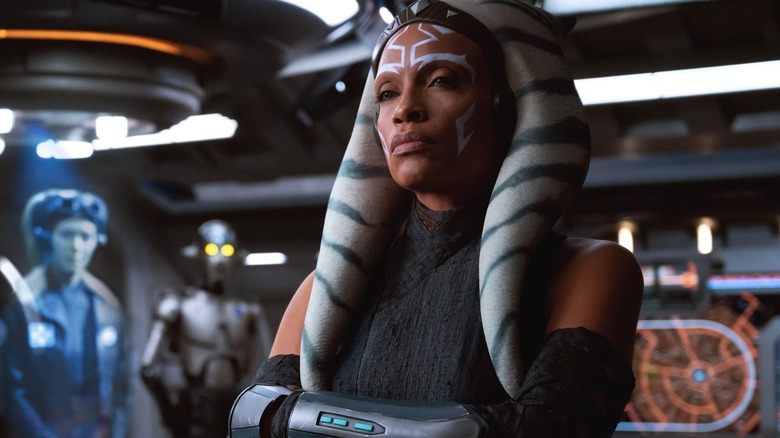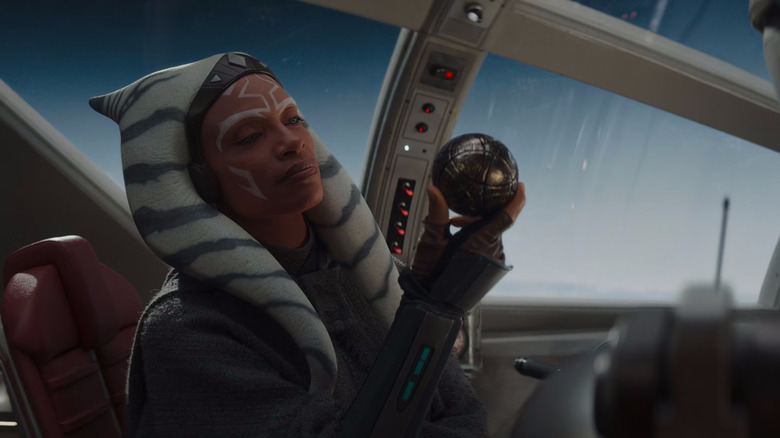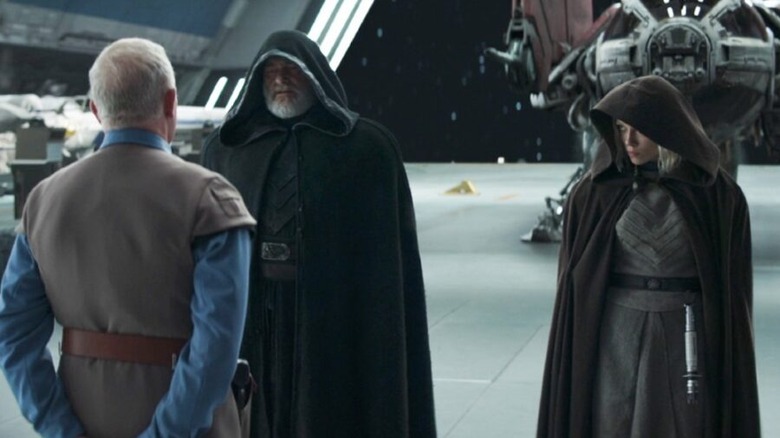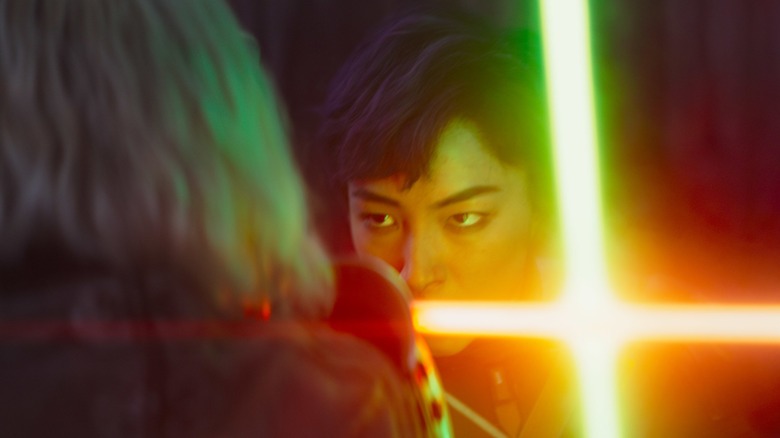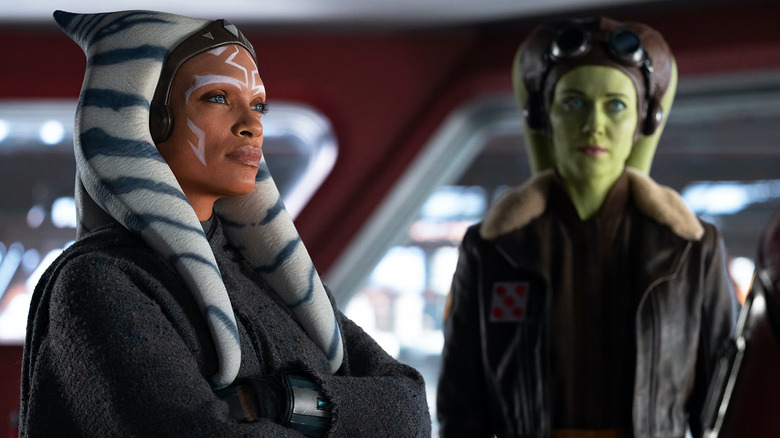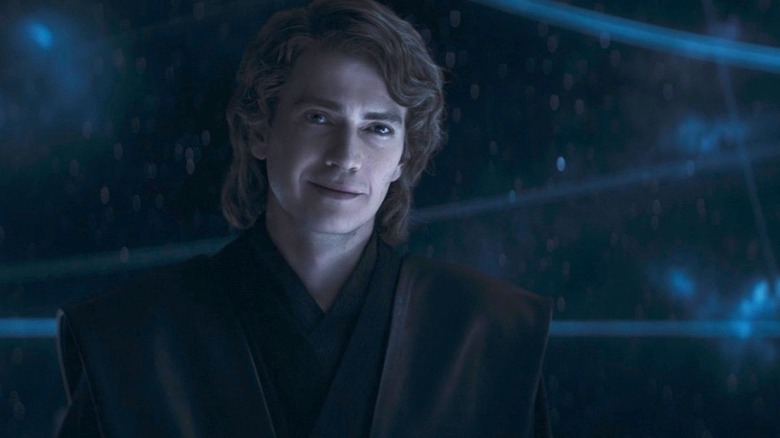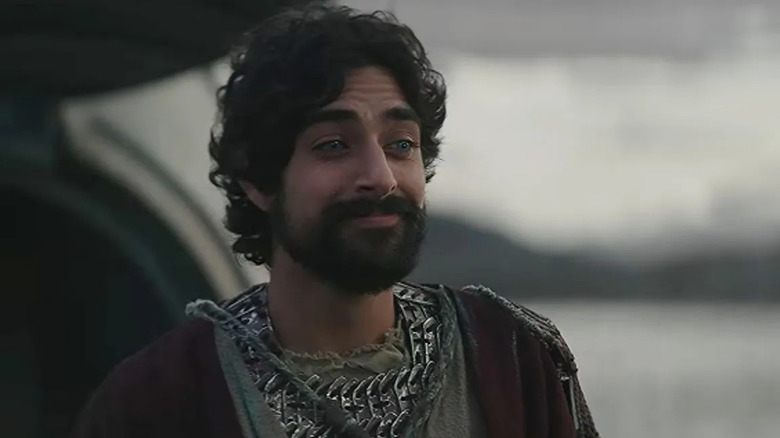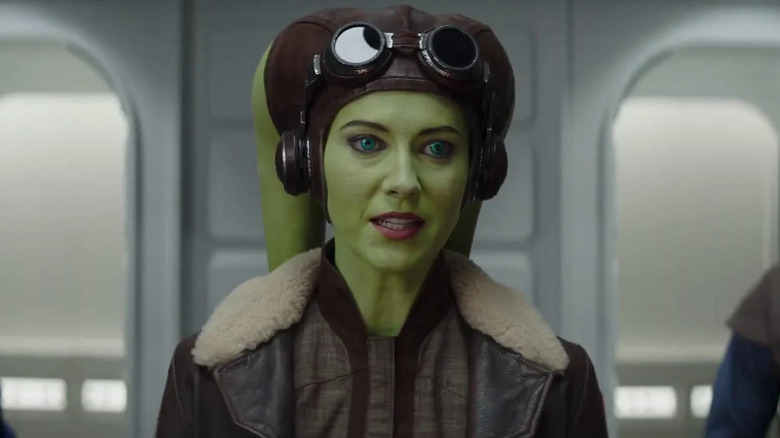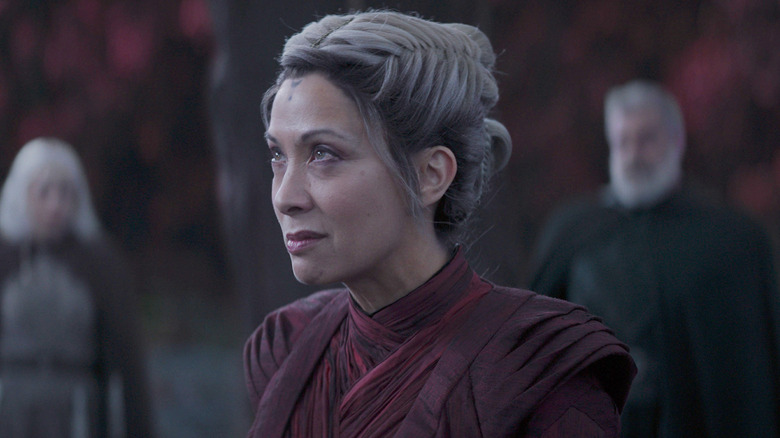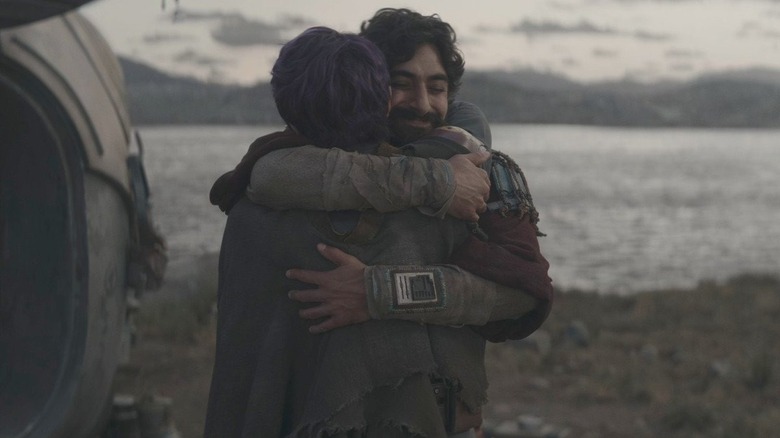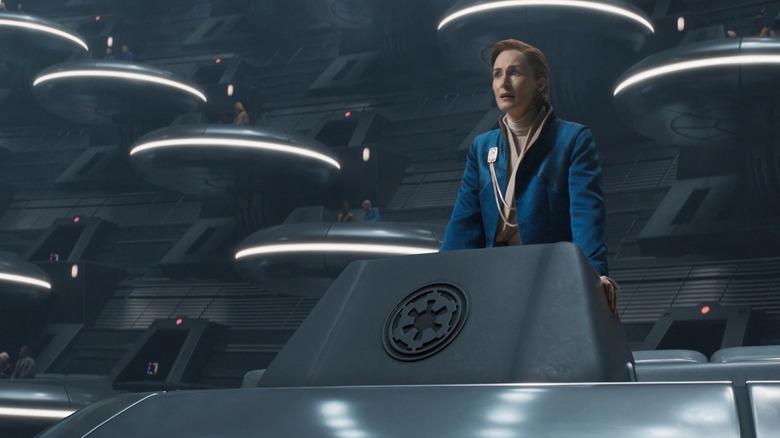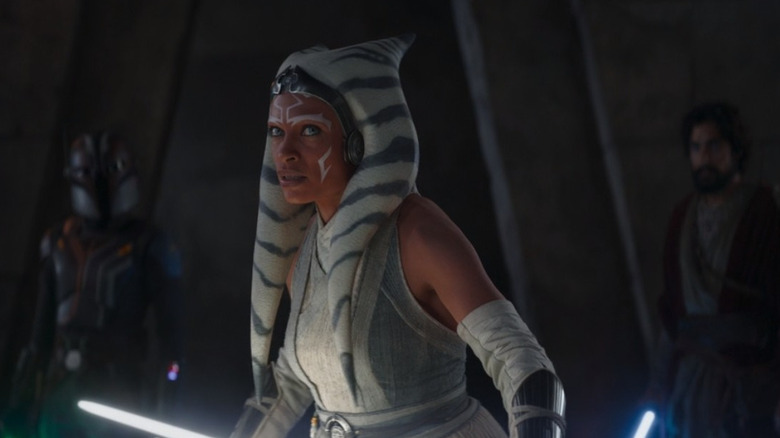Dumb Things Everyone Ignores In Ahsoka
The reception to "Ahsoka" has been all over the place. The Disney+ miniseries is the live-action culmination of the past decade of the animated "Star Wars" canon, which matters to some fans and is complete nonsense to others. In this continuation of the character arc beginning in "Star Wars: The Clone Wars," Ahsoka Tano (Rosario Dawson) reunites with "Star Wars Rebels" fan-favorites Sabine Wren (Natasha Liu Bordizzo) and Hera Syndulla (Mary Elizabeth Winstead) to rescue their long-lost friend and Jedi Ezra Bridger (Eman Esfandi). But where Ezra went, the Empire's deadliest tactician, Grand Admiral Thrawn (Lars Mikkelsen), awaits as well.
This miniseries brings some all-time favorite "Star Wars" characters to live action for the first time, but it's not without its stumbles along the way. The story in "Ahsoka" gets the characters where they need to go, but many of the finer details crumble under closer examination. While some of the CGI visuals are the best we've ever seen in a "Star Wars" TV show, the costumes, hair, and makeup often left a lot to be desired. In its totality, "Ahsoka" falls prey to many of the same issues that have been plaguing the "Star Wars" franchise for the entire Disney era. These are some of the dumbest things that everyone ignores in "Ahsoka."
More maps as MacGuffins
It is a trope that many fans have had enough of: Pointless maps that serve little purpose beyond moving the plot along. In "Star Wars: Episode VII – The Force Awakens," Rey (Daisy Ridley) finds a map that will lead her to Luke Skywalker (Mark Hamill), who she hopes will be her new master. The entire plot of the divisive "Star Wars: Episode IX – The Rise of Skywalker" revolves around a Sith wayfinder, which is just a map to Exegol. Even the videogame "Star Wars Jedi: Fallen Order" is about protecting a Jedi holocron that ends up being — you guessed it — a map of sorts.
Once again, "Ahsoka" delivers on this trope by making the first half of the series about finding a map to lead them to Ezra and Thrawn. In the show's most frustrating twist, the map isn't even what ultimately leads Ahsoka to Ezra. While the scene where Baylan Skoll (Ray Stevenson) destroys the map is pivotal to Sabine's character, it renders the first half of the plot of "Ahsoka" relatively inert. Since Ahsoka eventually hitches a ride with the purrgil to find Ezra on Peridia, the map is once again treated as a MacGuffin that is tossed away once its purpose has been served.
Why didn't Ahsoka ride the purrgil in the first place?
At the end of "Star Wars Rebels," Hera and Sabine see the purrgil take the Chimaera — Thrawn's Star Destroyer — away. These events set the search for Thrawn and Ezra into motion, and yet it doesn't occur to the main characters of "Ahsoka" until it's a last resort to try and contact the space whales to lead them to the missing pair. It is only after half the plot has transpired that Ahsoka uses the Force to reach out to the purrgil and convince them to lead her to Ezra.
If you consider what happens in Part Four prior to this decision, you can see what's being attempted here. From a thematic standpoint, it makes sense that Ahsoka needs to move on from her guilt about Anakin before reaching her goal. But let's consider for a second that Sabine has told Ahsoka how Ezra disappeared, and it makes little sense that summoning the purrgil wouldn't be Ahsoka's first thought. Instead, we are left with yet another map as an excuse to chase after some baddies before she arrives at the idea of her own volition.
The depiction of the New Republic's incompetence is too simplistic in the wake of Andor
While it may be unfair to compare everything to "Andor," in the wake of that show's nuanced depiction of the bureaucracy and cruelty of the Empire, the attempts of "Ahsoka" to foreshadow the fall of the New Republic fall flat. In showing that Empire sympathies remain inside the New Republic, "Ahsoka" sets up a dangerous world state that is susceptible to Thrawn's return. Unfortunately, the Republic already seems incompetent from top to bottom.
In the opening sequence of the series, a New Republic captain severely underestimates Baylan Skoll and his apprentice Shin Hati (Ivanna Sakhno) and foolishly welcomes them aboard, leading to the slaughter of his crew. When Hera and Ahsoka visit the Corellian shipyard in the second episode, the Imperials they encounter are pretty awful at keeping their secret under wraps. It doesn't take long for Ahsoka to catch on to what's going on at the factory, and even with the home-field advantage, the Imperial sympathizers couldn't come close to neutralizing her or Hera.
Sabine survives a fatal lightsaber wound
At the end of Part One of "Ahsoka," Sabine duels Shin for the map ... and loses. Shin escapes with the map and leaves Sabine with a lightsaber wound in her gut. In the old world of "Star Wars," this surely would have meant the end of Sabine Wren. However, in "Ahsoka," plot armor seems to be stronger than the blade of a lightsaber and Sabine joins the handful of "Star Wars" characters that survived a lightsaber wound.
When we next see Sabine, not only has she survived, but she is already well enough to speak and it isn't long before she is back on her feet again. The inconsistencies in the "Star Wars" universe can be frustrating for fans, and the way Sabine bounces back so quickly doesn't seem to correspond with the severity of the wound inflicted. While it may be the case that Sabine needed to be injured for Shin to escape with the map, perhaps the injury could've been slightly less serious so that her rapid recovery would make more sense.
Why does Ahsoka cross her arms all the time?
This might be a personal gripe, but it seems like Rosaria Dawson is crossing her arms in almost every scene. It is a small annoyance — and perhaps not as important in the grand scheme of things — but it leads to a very specific interpretation of the character.
Dawson's mannerisms make this older version of Ahsoka seem closed off. In an attempt to come across as a wise, older Jedi, we don't get to see very much of her emotion. In "The Clone Wars," Ahsoka was always a character who wore her feelings on her sleeve. Even if that's changed in the intervening years, this new depiction of the character seems to completely ignore the fact that she left the Jedi Order to do her own thing.
However, as some fans have pointed out on Reddit, this was a mannerism that Ahsoka picked up from Anakin, her former master. It can also be interpreted as a defensive gesture, and it may well be a directorial decision made by Dave Filoni to hint at Ahsoka's traumatic past which has led her to keep her guard up.
De-aged Hayden Christensen is a digital abomination
There is no doubt that Hayden Christensen is a much better actor than he was when he was in the prequel trilogy. His performance in "Ahsoka" injects his Anakin with the subtleties of Matt Lanter's performance from "The Clone Wars," bridging the gap between the two major depictions of Anakin prior to his fall. The character work done between Anakin and Ahsoka is also some of the best in the show.
Unfortunately, the unnecessarily de-aged Christensen is some of the most distracting CGI we've seen in some time. The more you look at Anakin in "Ahsoka" the more you can see him begin to look like an AI-generated person. Instead of just looking older than he should — if they hadn't used de-aging technology — he manages to look both unnaturally young and old at the same time. The more Disney uses this trick in its "Star Wars" material, the worse these half-digital humans seem to look.
Colored contact lenses break the illusion
In an effort to match the actor's eye colors to the canonical eye color of the character they were playing, "Ahsoka" uses colored contact lenses to create the illusion. The worst part of this choice is that you can obviously tell when the actors are wearing them — something the "Star Wars" subreddit has been all over.
The actors playing Ahsoka, Hera, Ezra, and Thrawn all wear colored lenses in "Ahsoka." Among the alien characters, the lenses used on Hera stand out as especially dead-eyed — perhaps because of how unnatural the fake blue looks. This would check out since the blue lenses that Eman Esfandi wears to become Ezra are equally distracting. The only lenses that work for the character are the glaring red eyes of Grand Admiral Thrawn as they are supposed to be so striking in the first place, and drawing attention to them is not necessarily a bad thing.
Ultimately, the use of these lenses leads to an uncanny effect that breaks the illusion of the world that the rest of the production has so lovingly crafted.
The foam head tails on Ahsoka and Hera
It is worth repeating that many of the visual effects in this series are top-notch, however, the hair and makeup on "Ahsoka" leave a bit to be desired. Unfortunately, these issues are particularly prevalent with the design of the series' main characters, making it impossible to ignore.
Had CGI been used for the Twi'lek head-tails, this would not age as well as practical effects, that much is clear. The problem is that the practical effects in "Ahsoka" just don't look very good. Like with the colored contact lenses, you can see the artificial nature of these headpieces in almost every shot of Hera and Ahsoka. You can see how little they move, and the way they clearly look like foam when they do move. This wasn't a huge issue when Ahsoka showed up for brief appearances in "The Mandalorian," but when two of the main characters of "Ahsoka" have such obviously fake head-tails, it becomes quickly distracting — and hard to fix with lighting tricks.
The Nightsisters background with the Empire is contradictory
Morgan Elsbeth (Diana Lee Inosanto) is a human, but it's clear from the events in "Ahsoka" that her allegiance is to Dathomir and the Nightsisters. So why did she join up with the Empire after they wiped out her people? And how exactly did she recruit a trio of actual Dathomirian sisters to go along with her plan and become loyal to a human?
In events depicted in "The Clone Wars" and the "Darth Maul: Son of Dathomir" comics, the Emperor makes a concerted effort to wipe out the Nightsisters and their leader Mother Talzin. Palpatine sees them as big as the Jedi, if not bigger, due to their ability to tap into Dark regions of the Force that even Palpatine doesn't fully understand. So it's a bit confusing as to why Morgan worked so hard to bring the Empire back into existence by helping Thrawn.
It makes sense that, as a human, Morgan would be able to work for the Empire and hide her secret allegiance to Dathomir. It's her motives that seem unclear. Perhaps this was one whole long con to bring the Force witches back into power. However, she will never see that future now, following her fatal duel with Ahsoka.
Ezra drops the question of how Sabine found him pretty quickly
When Sabine first arrives on Peridia and discovers Ezra's hiding place, one of the first questions he asks is how she found him. Sabine tells him they will get there later, and then it never comes up again.
While not that much time actually passes during the episodes on Peridia, and they spend the majority of it figuring out how to get back home, it's still hard to believe this doesn't come up again. Ezra and Sabine wind up spending a significant amount of time together offscreen, and it makes little sense that Ezra never thought to bring this up again.
This is extra important since answering the question of how Sabine found Ezra would force her to divulge that she willingly gave the map to Baylan to destroy. She is keeping a huge secret from him, but this never gets a chance to come up as a point of conflict or tension. Instead, Ezra and Sabine are once again on opposite ends of the universe, with their own battles to fight.
Mon Mothma hasn't aged in 15 years
One of the few "Star Wars" characters to be played by multiple actors, Mon Mothma proves that sometimes there is no need for de-aging. Originally played by Caroline Blakiston, Mothma was later portrayed by Genevieve O'Reilly in "Andor," and she appears again briefly in "Ahsoka." The problem is, she doesn't appear to have aged at all, even though some 15 years have passed between "Andor" and "Ahsoka."
"Andor" Season 1 takes place around the year 5 BBY and "Ahsoka" is sometime around 9 or 10 ABY. This puts about 15 years — and 15 very stressful, wartime years at that — between the series, and yet O'Reilly isn't made to look any different between the two shows.
This wouldn't even be a big deal if it didn't introduce a weird age inconsistency across the canon between the two actresses who have played the character. Blakiston was 50 years old when she played Mon Mothma in "Star Wars: Episode VI – Return of the Jedi," making her older than O'Reilly is now.
Morgan Elsbeth lets Ezra and Sabine walk right past her
In the "Ahsoka" finale, the scheming Morgan Elsbeth makes a very strange decision. Now that she has been fully transformed into a Nightsister she has more Force power than ever. Then she decides the best use of this newfound power is to duel Ahsoka one-on-one, instead of helping Thrawn with the objective. The Nightsister just lets Ezra and Sabine walk right past her, which in turn ensures that Ezra catches up to Thrawn and ultimately makes it onto the Chimaera.
At this moment it's clear the show wants a cool face-off, but we are left scratching our heads as to why Morgan lets the others go. She could have at least tried to take on all three, which would have delayed them just enough to trap them on Peridia, giving Thrawn ample room to escape and conquer the galaxy uncontested.
This once again brings the question of Morgan Elsbeth's intentions to our attention. What did she really want, what did she actually accomplish, and why was everything about that character so confusing?
